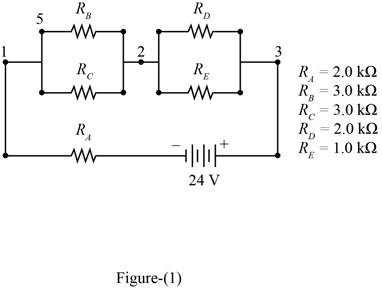
(a)
Interpretation:
The power dissipated between the points 1 and 2 is to be stated.
Concept introduction:
The resistive electrical circuit is the circuit which contains the voltage source and the resistor. The analysis of the circuit is done to evaluate the equivalent resistance, current through the circuit and power consumed by the circuit.
The power in dissipated in the electrical circuit is defined by
Answer to Problem 2.6QAP
The power dissipated between the points 1 and 2 is
Explanation of Solution
The below figure represents the electrical circuit.

Write the expression for the equivalent resistance between the point 1 and 2.
Write the expression for the equivalent resistance between the point 2 and 3.
Write the expression for the total equivalent resistance.
Write the expression for the current flowing through the circuit.
Here,
Write the expression for the power dissipated between the points 1 and 2.
Substitute
Substitute
Substitute
Substitute
Substitute
(b)
Interpretation:
The current drawn from the source is to be stated.
Concept introduction:
The resistive electrical circuit is the circuit which contains the voltage source and the resistor. The analysis of the circuit is to evaluating the equivalent resistance, current through the circuit and power consumed by the circuit.
The current drown the from the source is define as
Answer to Problem 2.6QAP
The current drown from the source is
Explanation of Solution
Write the expression for the equivalent resistance between the point 1 and 2.
Write the expression for the equivalent resistance between the point 2 and 3.
Write the expression for the total equivalent resistance.
Write the expression for the current flowing through the circuit.
Here,
Substitute
Substitute
Substitute
Substitute
(c)
Interpretation:
The voltage drop across the resistor
Concept introduction:
The resistive electrical circuit is the circuit which contains the voltage source and the resistor. The analysis of the circuit is done to evaluate the equivalent resistance, current through the circuit and power consumed by the circuit.
The voltage drop across the resistor is defined as
Answer to Problem 2.6QAP
The voltage drop across the resistance
Explanation of Solution
Write the expression for the equivalent resistance between the point 1 and 2.
Write the expression for the equivalent resistance between the point 2 and 3.
Write the expression for the total equivalent resistance.
Write the expression for the current flowing through the circuit.
Here,
Write the expression for the voltage drop across the resistor
Substitute
Substitute
Substitute
Substitute
Substitute
(d)
Interpretation:
The voltage drop across the resistance
Concept introduction:
The resistive electrical circuit is the circuit which contains the voltage source and the resistor. The analysis of the circuit is done to evaluate the equivalent resistance, current through the circuit and power consumed by the circuit.
The voltage drop across the resistor is defined as
Answer to Problem 2.6QAP
The voltage drop across the resistor
Explanation of Solution
Write the expression for the equivalent resistance between the point 1 and 2.
Write the expression for the equivalent resistance between the point 2 and 3.
Write the expression for the total equivalent resistance.
The voltage drop across the resistor
Write the expression for the voltage drop across the resistor
Substitute
Substitute
Substitute
Substitute
(e)
Interpretation:
The potential difference between the points 5 and 4.
Concept introduction:
The resistive electrical circuit is the circuit which contains the voltage source and the resistor. The analysis of the circuit is done to evaluate the equivalent resistance, current through the circuit and power consumed by the circuit.
The voltage drop across the resistor is defined as
Answer to Problem 2.6QAP
The potential difference across the points 5 and 4 is
Explanation of Solution
Write the expression for the equivalent resistance between the point 1 and 2.
Write the expression for the equivalent resistance between the point 2 and 3.
Write the expression for the total equivalent resistance.
Write the expression for the current flowing through the circuit.
Here,
Write the expression for the voltage drop across the resistor
Write the expression for the potential difference across the points 5 and 4.
Write the expression for the total voltage.
Substitute
Substitute
Substitute
Substitute
Substitute
Substitute
Substitute
Want to see more full solutions like this?
Chapter 2 Solutions
Principles of Instrumental Analysis
- I need help with the following two problems, understanding them in a simple manner. Can you please draw them out for me with a detailed explanation so that I can better comprehend? I'm a visual person, so I definitely need that. Thank you very much!arrow_forwardProblem 54, could you please explain it in detail? Thank you! Step by step, I'm really confused, so please don't make it overly complex. My question is to visually draw it out and demonstrate it to me; I'm confused about that problem, please (not just in words) but demonstrate it to me in all due essence (visually) with descriptions.arrow_forwardExplain the types of electromeric effects +E and -E.arrow_forward
- helpMEarrow_forwardDraw the major product of this reaction. Ignore inorganic byproducts. Assume that the water side product is continuously removed to drive the reaction toward products. (CH3)2NH, TSOH Drawingarrow_forwardSo, the first image is what I'm trying to understand regarding my approach. The second image illustrates my teacher's method, and the third image includes my notes on the concepts behind these types of problems.arrow_forward
 Principles of Instrumental AnalysisChemistryISBN:9781305577213Author:Douglas A. Skoog, F. James Holler, Stanley R. CrouchPublisher:Cengage Learning
Principles of Instrumental AnalysisChemistryISBN:9781305577213Author:Douglas A. Skoog, F. James Holler, Stanley R. CrouchPublisher:Cengage Learning Chemistry for Engineering StudentsChemistryISBN:9781285199023Author:Lawrence S. Brown, Tom HolmePublisher:Cengage Learning
Chemistry for Engineering StudentsChemistryISBN:9781285199023Author:Lawrence S. Brown, Tom HolmePublisher:Cengage Learning Principles of Modern ChemistryChemistryISBN:9781305079113Author:David W. Oxtoby, H. Pat Gillis, Laurie J. ButlerPublisher:Cengage Learning
Principles of Modern ChemistryChemistryISBN:9781305079113Author:David W. Oxtoby, H. Pat Gillis, Laurie J. ButlerPublisher:Cengage Learning Chemistry by OpenStax (2015-05-04)ChemistryISBN:9781938168390Author:Klaus Theopold, Richard H Langley, Paul Flowers, William R. Robinson, Mark BlaserPublisher:OpenStax
Chemistry by OpenStax (2015-05-04)ChemistryISBN:9781938168390Author:Klaus Theopold, Richard H Langley, Paul Flowers, William R. Robinson, Mark BlaserPublisher:OpenStax



